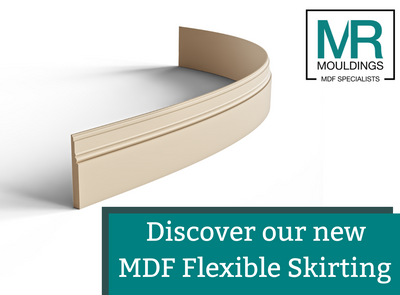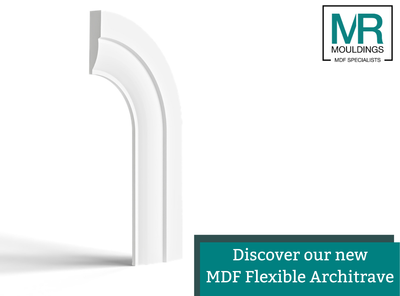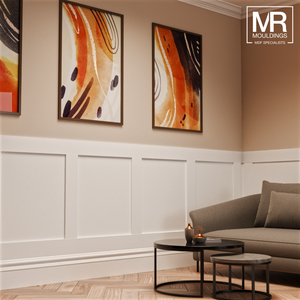
What Is the Point of a Skirting Board? Find Out Here
Walk into any well-finished room, and chances are you’ll notice the floors, the colour scheme, maybe even the lighting. But there’s one crucial design element that silently pulls everything together: the skirting board.
So, what is the point of a skirting board?
Skirting boards protect walls from scuffs, conceal floor gaps, and create a clean transition between wall and floor. They also enhance interior design by framing spaces and adding visual balance. Durable and decorative, skirting boards are an essential feature in both traditional and modern homes, offering function and style in one.
In this guide, we’ll walk you through the functional, aesthetic, and architectural value of skirting boards, why MDF is the smart modern choice, and how MR Mouldings can help you bring your space to life with precision-cut mouldings.
A Brief History of Skirting Boards
The concept of skirting boards dates back hundreds of years. In grand Georgian and Victorian homes, decorative hardwood skirting served to hide rough plaster finishes, protect walls from boot scuffs and chair legs, and signal wealth through elaborate detailing. Some were up to 400mm tall and richly carved, becoming almost a status symbol.
While modern architecture has shifted towards cleaner lines and minimal detailing, the functional purpose of skirting boards remains just as relevant, even if the design has evolved.
Today’s skirting is typically lower in profile, made from more accessible materials like MDF, and focused on performance as much as presentation.
What Is the Point of a Skirting Board?
Let’s answer the question at the heart of this post: What is the point of a skirting board in today’s homes?
1. Wall Protection
Walls are vulnerable, especially the lower section where:
-
Furniture is regularly moved
-
Hoovers and mops bash corners
-
Kids, pets, and daily traffic create wear
Skirting boards provide a physical barrier between the wall and anything that might bump into it. Instead of repairing cracked plaster or chipped paint every year, the skirting takes the brunt of the damage, and is much easier (and cheaper) to repaint or replace.
In busy homes, commercial settings, or rental properties, this function becomes essential for long-term maintenance.
2. Hiding Unsightly Gaps and Imperfections
Flooring, especially natural products like timber and laminate, requires a small expansion gap around the edge of the room to accommodate seasonal changes in humidity. Without this, the floor would buckle or crack.
The downside? That gap is unsightly.
A skirting board neatly conceals the expansion joint, as well as any rough plastering or uneven flooring edges. This gives your room a crisp and finished appearance, even in older or awkwardly shaped spaces.
Pro tip: Skirting is also useful for masking uneven floor levels in period properties, where the floor-to-wall transition might not be consistent.
3. Seamless Floor-to-Wall Transition
Skirting boards act as a visual and architectural buffer between the vertical and horizontal planes of your room, wall and floor. Without them, the space can feel disjointed or unfinished, especially where different materials meet.
They:
-
Smooth transitions between flooring types and wall textures
-
Help define zones or features within a space
-
Support shadow gaps or recessed lighting designs in modern schemes
This is why even minimalist interiors rely on square-edge or shadow-gap skirting to maintain that seamless design integrity.
4. Enhancing Interior Design and Aesthetics
While skirting boards are functional, they’re also a crucial interior design feature.
Whether you're restoring a Victorian hallway or designing a clean, Scandi-inspired living room, the right skirting profile can:
-
Add character and visual weight to the space
-
Frame the perimeter of the room, acting like a picture frame for the floor
-
Contrast or coordinate with wall colour for either subtlety or statement
-
Create proportion when paired with the ceiling height and other mouldings
Designers often use tall skirting to make a statement, or colour-matched skirting to create a flowing, tonal aesthetic. From Torus to Chamfered, Bullnose to Ogee, your chosen profile helps reinforce your chosen style.
5. Cable Management (In Some Profiles)
While not universal, certain skirting board profiles, especially deeper options, offer room to conceal electrical wires or networking cables behind them.
This is particularly useful when:
-
Retrofitting AV systems in period properties
-
Hiding speaker cables or ethernet wires in living rooms and offices
-
Avoiding floor-level trunking that spoils your aesthetic
While MR Mouldings focuses on traditional MDF profiles, many of them are suitable for minor cable concealment or can be adapted by professionals.
Why MDF Is the Ideal Material for Skirting Boards
Now that we’ve covered why skirting boards are essential, let’s look at why MDF skirting boards, in particular, are the best choice for modern interiors.
At MR Mouldings, we exclusively use Moisture-Resistant MDF (MR MDF) to offer the perfect balance of durability, finish quality, and cost-effectiveness.
Benefits of MDF Skirting Boards:
-
Smooth, consistent finish – No knots, grain or defects like timber
-
Easy to paint – Perfect for coloured skirting or a flawless white finish
-
No warping, twisting or splitting – Unlike natural softwood
-
Budget-friendly – Lower cost than hardwood with equal aesthetic impact
-
Environmentally responsible – Made from recycled wood fibres
-
Moisture-resistant – Suitable for kitchens, bathrooms, and utility rooms
-
Available in flexible form – For curved walls, bay windows or staircases
Want to explore your options? Browse our MDF Skirting Board Collection to see a wide range of profiles, heights, and finishes.
Modern Skirting Board Trends: Function Meets Style
Skirting boards aren’t just about function, they’re a key opportunity to enhance your space.
Here are the top design directions homeowners and designers are loving right now:
• Square Edge Minimalism
Perfect for modern, pared-back interiors, square or chamfered profiles blend into the background while keeping clean lines.
• Tall Skirting for Visual Impact
Taller skirting (150mm–230mm) is being used more frequently to create a grand, tailored look, particularly in new builds and renovations with generous ceiling heights.
• Painted Skirting for Bold Contrast
Painting skirting boards in darker or bolder colours (e.g. navy, graphite, sage green) creates contrast and frames the room effectively, especially against pale walls and timber flooring.
• Skirting and Panelling Combos
Combining skirting with dado rails and wall panelling adds depth and interest to hallways, staircases, or feature walls.
Need more ideas? Check out our blog on Coloured Skirting Board Ideas for design inspiration.
Do You Need Skirting Boards in a Modern Home?
Short answer: yes.
Even in ultra-minimalist homes where people experiment with no trim, the absence of skirting almost always leads to:
-
Visible floor expansion gaps
-
Scuff damage on the walls
-
A room that feels slightly “unfinished”
Skirting boards serve a critical function that hasn’t changed in centuries, and with modern manufacturing, they’ve never been more accessible or better suited to contemporary life.
Why Choose MR Mouldings?
When it comes to buying skirting boards, you need more than just nice profiles. You need reliability, quality, and expert service.
At MR Mouldings, we’re trusted by homeowners, builders, and tradespeople across the UK. Here’s why:
-
✅ UK-manufactured MDF mouldings using premium MR MDF
-
✅ Huge range of profiles, from Bullnose to Ogee
-
✅ Flexible MDF options for curved walls and complex projects
-
✅ Moisture-resistant by default, no need to upgrade
-
✅ Pre-primed and ready to paint
-
✅ Delivered quickly and securely to your site or door
Whether you’re fitting out a small extension or a multi-property development, our products are designed to save you time, hassle, and cost, without compromising on quality.
Final Thoughts: So, What Is the Point of a Skirting Board?
To recap: skirting boards do a lot more than just sit at the bottom of your walls.
They:
-
Protect against knocks, scuffs, and daily wear
-
Conceal floor gaps and finishing inconsistencies
-
Complete your room with a visual structure
-
Enhance or elevate your interior design
-
Allow for easy repainting, wire concealment, and transitions
When chosen well, they’re subtle. But if you remove them? You’ll notice something’s missing.
Ready to Finish Your Room the Right Way?
From traditional homes to modern apartments, MDF skirting boards from MR Mouldings give you performance, durability, and design flexibility at a great price.
👉 Explore Our Full MDF Skirting Range
Made in the UK. Built to last. Delivered to your door.
Let your walls and your interiors look their best.




